

Custom-Grown Bones, and Other Wild Advances in Regenerative Medicine. Bioélectronique : un implant biodégradable pour régénérer les nerfs. La repousse nerveuse peut être accélérée via la stimulation électrique.

Des chercheurs ont inventé un implant à poser directement sur le nerf endommagé et pouvant être activé de l'extérieur pour un traitement en continu. Accidents de voiture, de sport ou même, doigt coincé dans une porte : les lésions traumatiques des nerfs périphériques concernent des milliers de patients chaque année. Heureusement, contrairement aux fibres nerveuses du système nerveux central dont l'atteinte entraîne une paralysie permanente, celles du système périphérique peuvent se régénérer et le contrôle actif du muscle peut être restauré.
Néanmoins, cette reconstruction est très lente et reste souvent incomplète, menant à une perte de sensibilité et de motricité des membres touchés. Why scientists are transplanting artificially grown “brains” into living brains. Science is awesome, but it can involve doing some pretty strange things.
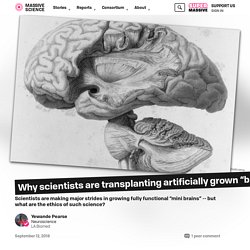
From showing that blood from a young mouse can reverse the signs of aging in an older one by joining the mice together, to hijacking the circulatory system of a mouse with no immune system to grow an artificial ear on its back - science can get freaky. Now, scientists are transplanting “mini-brains” into the little brains of mice. Before you write us off as crazy cackling scientists in basements, let me explain why. “Mini-brains,” or brain organoids, the latest development in stem cell technology, are organized 3D cell structures made up of different brain cells, which resemble the complexity of the human brain. When it comes to regrowing tails, neural stem cells are the key.
Cut off a salamander's tail and, in a few weeks, a near-perfect replacement grows.
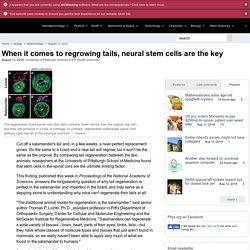
Do the same to a lizard and a new tail will regrow, but it won't be the same as the original. By comparing tail regeneration between the two animals, researchers at the University of Pittsburgh School of Medicine found that stem cells in the spinal cord are the ultimate limiting factor. This finding, published this week in Proceedings of the National Academy of Sciences, answers the longstanding question of why tail regeneration is perfect in the salamander and imperfect in the lizard, and may serve as a stepping stone to understanding why mice can't regenerate their tails at all. "The traditional animal model for regeneration is the salamander," said senior author Thomas P. Lozito, Ph.D., assistant professor in Pitt's Department of Orthopaedic Surgery, Center for Cellular and Molecular Engineering and the McGowan Institute for Regenerative Medicine. More information: Aaron X. This working heart tissue is made from spinach. In Brief A new way to create working heart tissue using plants could eventually help us treat heart attack patients or others whose hearts have difficulty contracting.
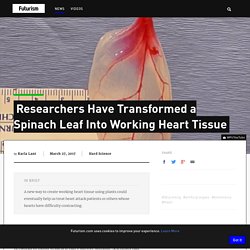
Researchers from the Worcester Polytechnic Institute (WPI) have transformed a spinach leaf into functional heart tissue. The team’s goal was to recreate human organ tissue down to the fragile vascular networks of blood vessels it can’t survive without. Scientists had previously attempted to 3D print intricate vascular networks without success. This breakthrough could mean that the delicate vascular systems of plants are the key. Scientists have Created Sheep-Human Hybrids For The First Time. For the first time, researchers have been able to produce a sheep embryo that has a small amount of human genetic code.
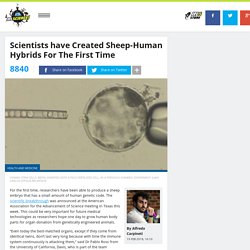
The scientific breakthrough was announced at the American Association for the Advancement of Science meeting in Texas this week. This could be very important for future medical technologies as researchers hope one day to grow human body parts for organ donation from genetically engineered animals. Fetal Protein Band-Aids Could Let Wounds Heal Without Visible Scars. Whether it’s a surgical wound, stretch marks, or the result of falling off your bike as a kid, most of us have unsightly scars we wish would go away.

But what if there was a way to prevent a visible scar from ever forming? Well, researchers have now developed a band-aid that can do just that, not only promoting healing but also significantly reducing scarring too. Syndrome usher. Bientôt une pilule pour remplacer le sport ? La cardiotrophine CT1 est une molécule capable de faire croire à votre cœur que vous faites de l'exercice.

Dans un modèle animal d'insuffisance cardiaque, elle a amélioré la santé du cœur, ce qui permet d'imaginer des applications médicales chez l'Homme. Ce qu'il faut retenir CT1 est efficace dans des modèles de rongeurs et pourrait aider à traiter l’insuffisance cardiaque.La cardiotrophine CT1 stimule la croissance du cœur et ses capacités à pomper le sang, tout comme le ferait l’exercice.CT1 est efficace dans des modèles de rongeurs et pourrait aider à traiter l’insuffisance cardiaque.La cardiotrophine CT1 stimule la croissance du cœur et ses capacités à pomper le sang, tout comme le ferait l’exercice. Dans le cas d'une insuffisance cardiaque, le cœur n'arrive pas à pomper suffisamment de sang, souvent parce qu'un infarctus a endommagé le tissu cardiaque. C'est une cause importante de décès et d'incapacité dans les pays occidentaux.
Rat Heart Used To Create A Miniature Human Heart. One of the major aims of modern medicine is to be able to grow human organs in a lab.
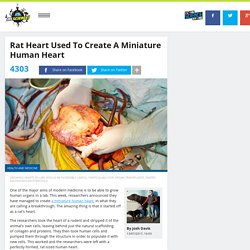
This week, researchers announced they have managed to create a miniature human heart, in what they are calling a breakthrough. The amazing thing is that it started off as a rat's heart. Bromodeoxyuridine (BrdU) in adult neurogenesis research - Part 1. In this two-part series on the thymidine analog BrdU, we tell the story of how BrdU revolutionized the field of neurogenesis as well as its recently identified limitations as a lineage tracer for neurogenesis studies.
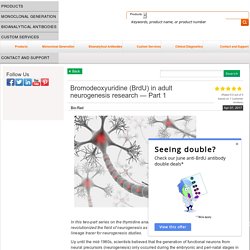
Up until the mid-1960s, scientists believed that the generation of functional neurons from neural precursors (neurogenesis) only occurred during the embryonic and peri-natal stages in mammals. Essentially, it was thought that loss of neurons was an irreversible process in the adult brain. Altman and Das (1965) provided the first evidence of adult neurogenesis in post-natal rats using autoradiographic analysis of [3H] thymidine incorporation into DNA during the S phase of cell growth. However, it was still unclear whether new neurons were produced in the brains of adult humans. By the 1990s, scientists had begun studying DNA replication using non-autoradiography techniques. In clinical settings, BrdU has been used to monitor cancer progression (Waldman et al. 1988). Controversial Study Wants To Resurrect Brain-Dead People. A US biotech company has laid out a highly controversial plan to do the unimaginable – resurrect brain-dead people using the power of stem cells.
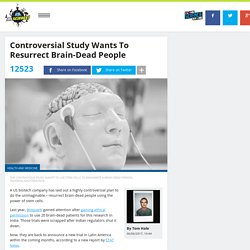
Last year, Bioquark gained attention after gaining ethical permission to use 20 brain-dead patients for this research in India. Those trials were scrapped after Indian regulators shut it down. Now, they are back to announce a new trial in Latin America within the coming months, according to a new report by STAT News. In the previous trials, the basic idea was to inject stem cells into the patient's upper spinal cord along with a cocktail of peptides shown to help neurons develop.
They then aimed to stimulate the brain using electrical nerve stimulation and laser therapy. Stem cells, undifferentiated cells that have the potential to develop into many different types of specialized cells, have already been shown to hold huge potential for biomedical sciences, whether that’s treating age-related macular degeneration or hair loss.
Des cellules souches immortalisées permettent aux scientifiques de créer du sang artificiel en quantité illimitée. Cerveau : la greffe de neurones n'est plus un rêve. Log In - New York Times. Log In Don't have an account? Sign up here » Facebook. ?articles. Stem cell research was going strong by the late 1990s. Developmental biologists had been using human embryonal carcinoma (EC) cells at the bench since the mid-1980s, but work on embryonic stem cells (ESCs) and embryonic germ cells in the mouse had given researchers hope that they could derive pluripotent cells from humans that wouldn’t have the EC cells’ abnormal genomes.
Leading up to the new millennium, a handful of researchers were working furiously toward this goal. Restrictions to federal funding for human embryo research in the U.S. severely hindered efforts, but in November 1998, two labs supported by private funding from the Geron Corporation succeeded. Mining human embryos and fetuses for pluripotent cells incited a public outcry. “It was clear once we published that all hell broke loose,” says Gearhart. Un intestin humain fonctionnel reconstitué à partir de cellules souches. « Engineered human pluripotent stem cell-derived intestinal tissues with a functional enteric nervous system » Michael J. Workman1#, Maxime M. Mahe2#, Stephen Trisno1, Holly M.
Poling2 Carey L. Watson2, Nambirajan Sundaram2, Ching-Fang Chang1,3, Jacqueline Schiesser1, Philippe Aubert4, Edouard G. 1 Division of Developmental Biology, Regrowing limbs? Gene map of how lizards regrow tails offers insight to human regenerative medicine. Boosting the Immune System to Effect Repairs and Fight Disease. Interest in Stem Cell Therapy Is Rising If anything, enthusiasm for stem cell technology can be too great. For example, earlier in the year, the U.S. Food & Drug Administration decided to take a closer look at clinics that provide stem cell treatments. The FDA hopes that closer regulation may not only curb unproven therapies, but also enhance confidence in truly effective interventions. Tétraplégique, il retrouve l'usage de ses bras grâce à des cellules souches.
Researchers Create Regenerative Tooth Fillings. Every year, dentists fill millions of cavities from teeth that have decayed. Ordinarily, this does its job in protecting the inner pulp from harm, but in around 10 percent of cases they fail. This requires the dentist to perform a root canal and completely remove all the infected tissue from the center of the tooth. But what if there was a way in which to encourage the tooth to repair itself? Well that is exactly what researchers at the University of Nottingham and Harvard University are trying to achieve. First Lab-Grown Skin to Sweat and Grow HairTrending. Image Credit: Takashi Tsuji | RIKEN Center in Japan Just in the past few months, biomedical engineers have created lab-grown heart cells, retinal nerve cells, and even vocal cords that can ‘talk.’
Adding to the astonishing list of body parts engineered in the lab, researchers in Japan announced they have produced lab-grown mouse skin that can sweat and grow hair, just like its biological counterpart! To engineer this life-like skin, Takashi Tsuji and his team at Japan’s RIKEN Center for Developmental Biology, first took cells from the gums of mice. Then, by applying pluripotency factors to the cells, the team transformed them into induced pluripotent stem cells (iPSCs). These iPSCs are undifferentiated and have the capacity to mature into any cell in the body. Beating Human Hearts Grown In Laboratory Using Stem Cells. Right now, there are 4,186 people waiting for a heart transplant in the U.S., but with a huge donor shortage not all of these patients are likely to survive. Growing transplantable hearts in a laboratory has been a long-standing dream within the medical community, and a study in the journal Circulation Research has moved it one step closer to reality: A team of researchers have successfully grown a beating human heart in the laboratory using stem cells.
Previous research has shown how 3D printers can be used to manufacture 3D heart segments using biological material. Although vacant of any actual heart cells, these structures provided the “scaffold” on which heart tissue could be grown. Now, a team from both Massachusetts General Hospital (MGH) and Harvard Medical School has taken this scaffolding concept and combined it with stem cells for some truly spectacular results. Miracle Powder Regrows Fingers, Now Thigh Muscle for Marine. What makes muscles grow? - Jeffrey Siegel. While biologists have uncovered the cellular mechanisms that lead to muscle growth, the practical applications have traditionally remained the expertise of bodybuilders. Resistance exercise such as weightlifting is the most common way to stimulate muscle protein synthesis, which leads to muscle growth or hypertrophy when supported by adequate nutrition. Man With Severed Spinal Cord Walks Again After Cell Transplant.
Stem Cell Treatment Successfully Restores Sight. Les incroyables promesses de la médecine régénératrice. Scientists Generate Sperm Precursors From Skin Cells Of Infertile Men. Factory Made Blood Nearing Human Trials. Implantable Scaffold Regenerates Lost Bone. Artificial Lung Grown In Laboratory. From pluripotency to totipotency. Protein Keeps Aging Heart Young at Heart. Engineered Human Intestines Function Like the Real Thing in Mice. Most MS Patients Who Received Stem Cell Transplants Still in Remission Years Later. Molly Stevens: A new way to grow bone. An Experimental Stem Cell Treatment Lead To A Woman Accidentally Growing A Nose On Her Spine.
Anthony Atala: Growing new organs. Le ver plat peut régénérer son corps à partir d'une seule cellule. Scientists Regenerate Living Organs For The First Time. Tooth-Derived Stem Cells Make Brain-Like Cells. Scientists Regenerate Leg Muscles With Pig Bladder Tissue. Study Suggests Salamanders Could Hold The Key To Human Limb Regeneration.